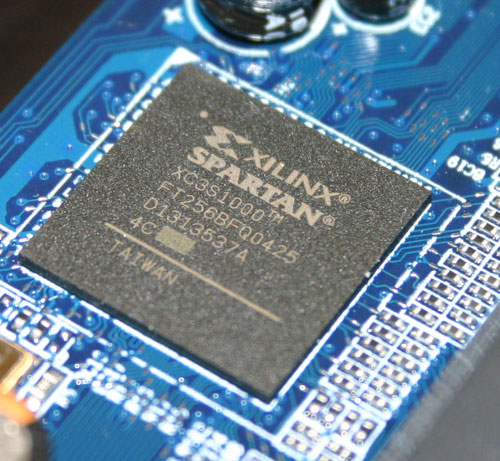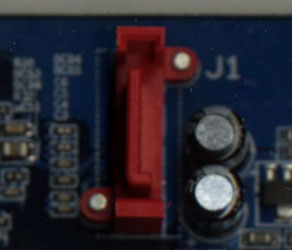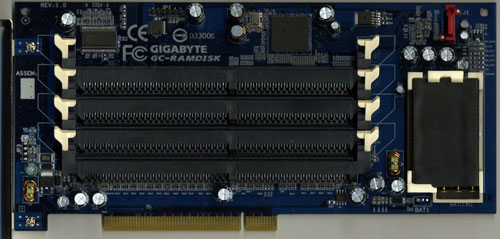Gigabyte's i-RAM: Affordable Solid State Storage
by Anand Lal Shimpi on July 25, 2005 3:50 PM EST- Posted in
- Storage
We All Scream for i-RAM
Gigabyte sent us the first production version of their i-RAM card, marked as revision 1.0 on the PCB.There were some obvious changes between the i-RAM that we received and what we saw at Computex.
First, the battery pack is now mounted in a rigid holder on the PCB. The contacts are on the battery itself, so there's no external wire to deliver power to the card.


The Xilinx FPGA has three primary functions: it acts as a 64-bit DDR memory controller, a SATA controller and a bridge chip between the memory and SATA controllers. The chip takes requests over the SATA bus, translates them and then sends them off to its DDR controller to write/read the data to/from memory.
Gigabyte has told us that the initial production run of the i-RAM will only be a quantity of 1000 cards, available in the month of August, at a street price of around $150. We would expect that price to drop over time, and it's definitely a lot higher than what we were told at Computex ($50).
The i-RAM is outfitted with 4 184-pin DIMM slots that will accept any DDR DIMM. The memory controller in the Xilinx FPGA operates at 100MHz (DDR200) and can actually support up to 8GB of memory. However, Gigabyte says that the i-RAM card itself only supports 4GB of DDR SDRAM. We didn't have any 2GB unbuffered DIMMs to try in the card to test its true limit, but Gigabyte tells us that it is 4GB.
The Xilinx FPGA also won't support ECC memory, although we have mentioned to Gigabyte that a number of users have expressed interest in having ECC support in order to ensure greater data reliability.
Although the i-RAM plugs into a conventional 3.3V 32-bit PCI slot, it doesn't use the PCI connector for anything other than power. All data is transfered via the Xilinx chip and over the SATA connector directly to your motherboard's SATA controller, just like any regular SATA hard drive.

With SATA as the only data interface, Gigabyte made the i-RAM infinitely more useful than software based RAM drives because to the OS and the rest of your system, the i-RAM appears to be no different than a regular hard drive. You can install an OS, applications or games on it, you can boot from it and you can interact with it just like you would any other hard drive. The difference is that it is going to be a lot faster and also a lot smaller than a conventional hard drive.
The size limitations are pretty obvious, but the performance benefits really come from the nature of DRAM as a storage medium vs. magnetic hard disks. We have long known that modern day hard disks can attain fairly high sequential transfer rates of upwards of 60MB/s. However, as soon as the data stops being sequential and is more random in nature, performance can drop to as little as 1MB/s. The reason for the significant drop in performance is the simple fact that repositioning the read/write heads on a hard disk takes time as does searching for the correct location on a platter to position them. The mechanical elements of hard disks are what make them slow, and it is exactly those limitations that are removed with the i-RAM. Access time goes from milliseconds (1 x 10-3) down to nanoseconds (1 x 10-9), and transfer rate doesn't vary, so it should be more consistent.
Since it acts as a regular hard drive, theoretically, you can also arrange a couple of the i-RAM cards together in RAID if you have a SATA RAID controller. The biggest benefit to a pair of i-RAM cards in RAID 0 isn't necessarily performance, but now you can get 2x the capacity of a single card. We are working on getting another i-RAM card in house to perform some RAID 0 tests. However, Gigabyte has informed us that presently, there are stability issues with running two i-RAM cards in RAID 0, so we wouldn't recommend pursuing that avenue until we know for sure that all bugs are worked out.












133 Comments
View All Comments
Aganack1 - Monday, July 25, 2005 - link
i thought they said that they were only going to make 1000. enought for the crazies who have money to burn...P.S. if any of you crazies are reading this i could burn some of that money for you... just let me know.
Houdani - Monday, July 25, 2005 - link
Thanks for running through the multiple roles for which the iRam might be useful. I'm rather surprised it wasn't MORE useful in the benches. I'd be interested in learning (i.e. slacking back and reading the results of someone else's research) why the i-Ram is still as large a bottleneck as it is. Yes it's faster than the HD, but why isn't it much, much faster? Are we seeing OS inefficiency or something else altogether?In the end, though, it doesn't fit my needs particularly well, so I'll pass this round. Maybe a future version will be more appealing in terms of cost, speed, size.
Sunbird - Monday, July 25, 2005 - link
maybe the SATA interface isn't fast enough?pio!pio! - Monday, July 25, 2005 - link
I'm constantly shuffling 1--3 gb mpeg2 files around...this would be greatGed - Monday, July 25, 2005 - link
Would it be possible for an NVIDIA or ATI graphics card that used TurboCache or HyperMemory to make use of the i-RAM?That might be interesting.
Anton74 - Monday, July 25, 2005 - link
No, absolutely not. Even if it were, the SATA interface is *way* too slow to be of use for something like that.And even if that were not a factor, why spend that kind of money on the i-RAM where the same amount would buy a *much* superior video card with its own dedicated memory?
Anton
kleinwl - Monday, July 25, 2005 - link
I think that this would be very helpful as a page file for workstations. Older workstations may be maxed out with 4GB and windows 2000 (which the company does not want to move over to xp-64) and still need additional ram for CAD/CFD/etc. This would be an easy upgrade with a reasonable amount of performance increase.sandorski - Monday, July 25, 2005 - link
Was hoping it would offer more, especially as a Pagefile. Any plans to make a PCI-e version(IIRC PCI-e has a ton more bandwidth than SATA), that would likely make this a Must-have. As it stands now I'd only use it for the silence in a HT Setup.Gatak - Monday, July 25, 2005 - link
Using PCI/PCI-e for transfers would require OS drivers which wouldn't be available for all OSes.sprockkets - Tuesday, July 26, 2005 - link
Keep in mind that for many years the ide/sata controllers are NOT on the PCI bus of the southbridge, so PCI is not a limitation.